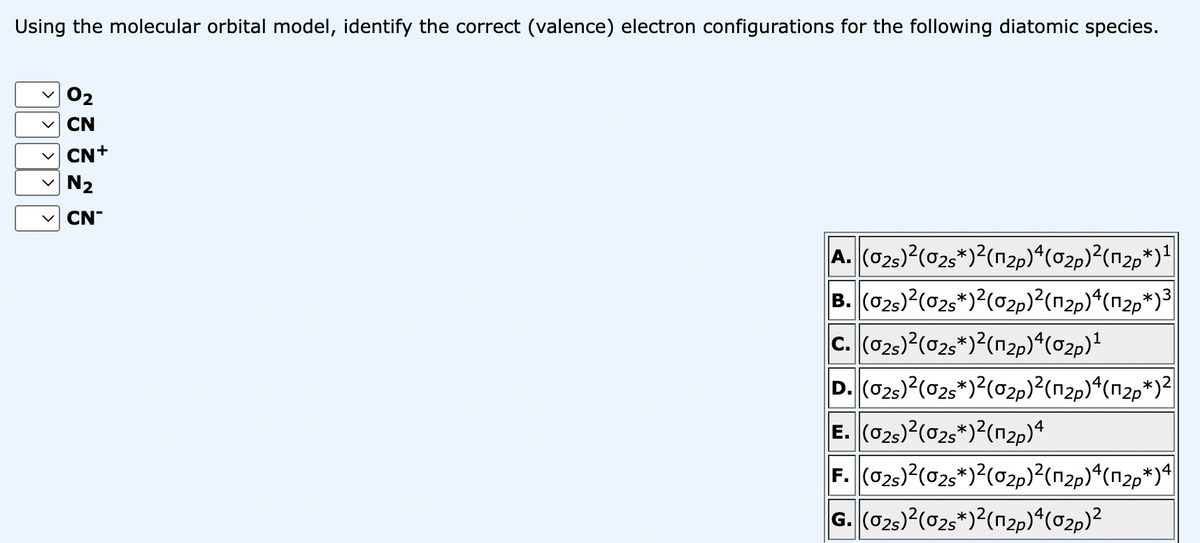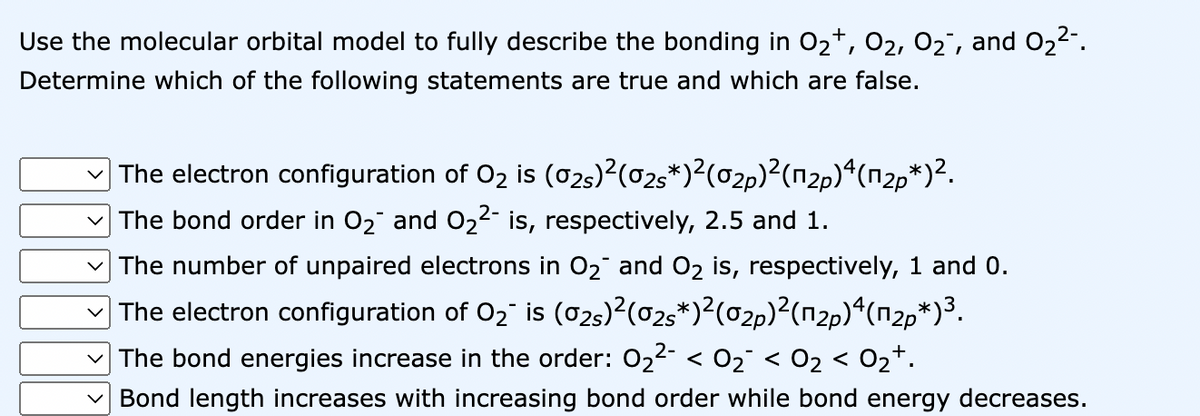General Chemistry - Standalone book (MindTap Course List)
11th Edition
ISBN:9781305580343
Author:Steven D. Gammon, Ebbing, Darrell Ebbing, Steven D., Darrell; Gammon, Darrell Ebbing; Steven D. Gammon, Darrell D.; Gammon, Ebbing; Steven D. Gammon; Darrell
Publisher:Steven D. Gammon, Ebbing, Darrell Ebbing, Steven D., Darrell; Gammon, Darrell Ebbing; Steven D. Gammon, Darrell D.; Gammon, Ebbing; Steven D. Gammon; Darrell
Chapter10: Molecular Geometry And Chemical Bonding Theory
Section: Chapter Questions
Problem 10.23QP
Related questions
Question

Transcribed Image Text:Using the molecular orbital model, identify the correct (valence) electron configurations for the following diatomic species.
02
CN
CN+
N₂
CN
A. (02s)²(0₂s*)²(1₂)ª(0₂)²(п²*)¹
B. (02s)2(02s*)2(02p)2(n2p)4(n2p*)3
C. (02s)²(02s*)2(₂p)4(0₂p)¹
D. (02s)2(02s*)2(02p)²(n2p)4(n2p*)2
E. (02)²(02s*)2(n₂p)4
F. (02s)²(02s*)²(0₂p)²(п²p)ª(₪²p*)4
G. (02s)²(0₂s*)²(¹₂)4(0₂)²

Transcribed Image Text:Use the molecular orbital model to fully describe the bonding in O₂+, 0₂, 0₂¯, and 0₂²-.
Determine which of the following statements are true and which are false.
The electron configuration of O₂ is (02s)²(02s*)²(02p)²(1₂p) 4 (n₂p*)².
✓The bond order in O₂ and O₂2- is, respectively, 2.5 and 1.
The number of unpaired electrons in O₂ and O₂ is, respectively, 1 and 0.
The electron configuration of O₂¯ is (02)²(02s*)²(02p)²(12p)4(п²*)³.
The bond energies increase in the order: 0₂²- < 0₂¯ < 0₂ < 0₂¹.
Bond length increases with increasing bond order while bond energy decreases.
Expert Solution
This question has been solved!
Explore an expertly crafted, step-by-step solution for a thorough understanding of key concepts.
Step by step
Solved in 4 steps with 3 images

Knowledge Booster
Learn more about
Need a deep-dive on the concept behind this application? Look no further. Learn more about this topic, chemistry and related others by exploring similar questions and additional content below.Recommended textbooks for you

General Chemistry - Standalone book (MindTap Cour…
Chemistry
ISBN:
9781305580343
Author:
Steven D. Gammon, Ebbing, Darrell Ebbing, Steven D., Darrell; Gammon, Darrell Ebbing; Steven D. Gammon, Darrell D.; Gammon, Ebbing; Steven D. Gammon; Darrell
Publisher:
Cengage Learning

Chemistry by OpenStax (2015-05-04)
Chemistry
ISBN:
9781938168390
Author:
Klaus Theopold, Richard H Langley, Paul Flowers, William R. Robinson, Mark Blaser
Publisher:
OpenStax


General Chemistry - Standalone book (MindTap Cour…
Chemistry
ISBN:
9781305580343
Author:
Steven D. Gammon, Ebbing, Darrell Ebbing, Steven D., Darrell; Gammon, Darrell Ebbing; Steven D. Gammon, Darrell D.; Gammon, Ebbing; Steven D. Gammon; Darrell
Publisher:
Cengage Learning

Chemistry by OpenStax (2015-05-04)
Chemistry
ISBN:
9781938168390
Author:
Klaus Theopold, Richard H Langley, Paul Flowers, William R. Robinson, Mark Blaser
Publisher:
OpenStax


Chemistry: An Atoms First Approach
Chemistry
ISBN:
9781305079243
Author:
Steven S. Zumdahl, Susan A. Zumdahl
Publisher:
Cengage Learning

Chemistry
Chemistry
ISBN:
9781305957404
Author:
Steven S. Zumdahl, Susan A. Zumdahl, Donald J. DeCoste
Publisher:
Cengage Learning

Chemistry: The Molecular Science
Chemistry
ISBN:
9781285199047
Author:
John W. Moore, Conrad L. Stanitski
Publisher:
Cengage Learning